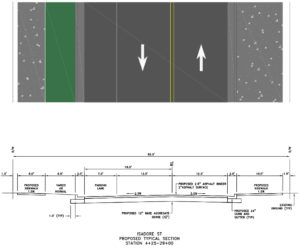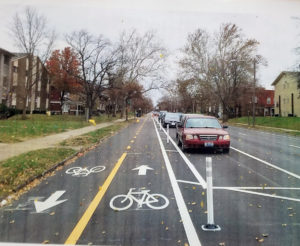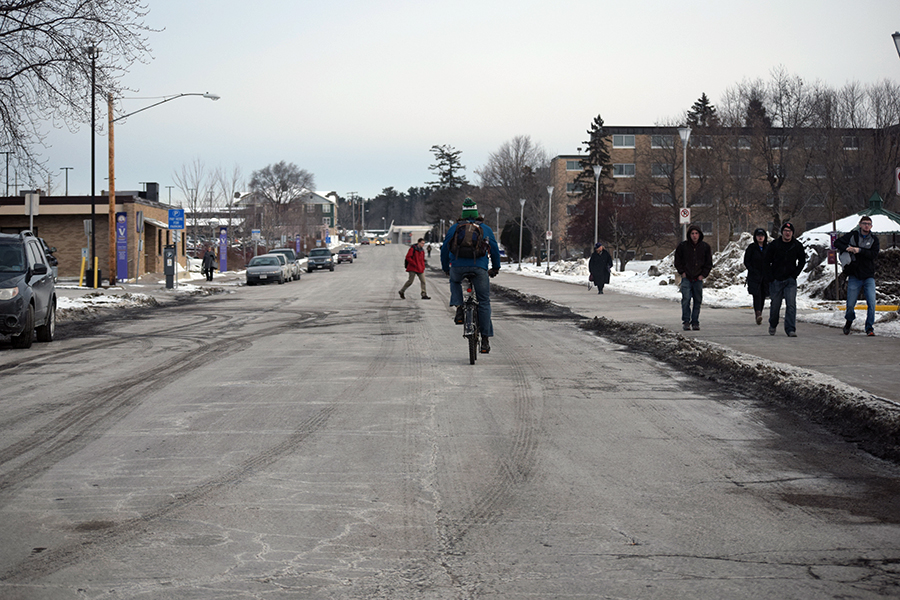Councilwoman argues design for Isadore St. rebuild not ‘modern’ enough
By Brandi Makuski
One councilwoman wants the city to choose a more bike-friendly design during its upcoming rebuild of Isadore Street.
The total reconstruction of the Isadore, between Portage St. and Maria Dr., is expected to begin sometime this year after being approved by the city council last year. But in January, Ald. Tori Jennings distributed a photocopy of a proposed new design for the road, one which includes bicycle lanes and exceeds the footprint available to the city.
Jennings initiated discussion on the topic at January and February meetings of the board of public works, which were only indirectly included on the agenda as an update under the director’s report.
In January, Jennings called the rebuild a “once-in-a-lifetime opportunity”, adding that inclusion of bicycle lanes would improve safety and “showcase what’s possible on this kind of corridor.” The Isadore St. remodel had already been approved by the council and was not a specific agenda item, so discussion was minimal and no changes were made.
Jennings voiced her concerns again at the Feb. 12 board meeting, asking for further discussion on the issue during what is normally a routine formality of accepting a director’s report—an agenda item in which Public Works Director Scott Beduhn outlined progress made in the planning phases for Isadore St. and several other ongoing projects.

“Whatever reconstruction is done to this road is what will be that road for the next 90 to 100 years,” Jennings said. “To reconstruct that road in a 20th century configuration, without modernizing it, is a waste of taxpayer dollars, and an opportunity missed.”
Jennings then made a motion to delay the project, which Wiza said wasn’t appropriate because the project had already been approved.
In order to make the alternative design work, Wiza said UWSP would need to give up some of its land, a request he said the university has already turned down.
“So the university determines what city streets are?” Jennings asked.
“No, the university determines what to do with their property,” Wiza replied. “Isadore Street is one of the worst streets in the city; we’ve been talking about that for a while. But if we don’t have the cooperation of the university to expand, [they] clearly don’t want that design. They want the standard design.”
Wiza also asked Jennings if she had any recent conversations with the university indicating they’d changed their decision, she replied, “No.”
Beduhn said the university would need to give up at least six feet of its property, and the cost of relocating some of its underground utilities wouldn’t be “economical.” The change would also increase the city’s cost of the budgeted $1M project.
Bicycle usage was significantly higher on Reserve St. than on Isadore St., Beduhn added, so even if the space was available, the roadway rebuild didn’t necessarily warrant the inclusion of bike lanes.
Wiza said Monday’s interaction was the “first he’d heard of concerns from any of the alderpersons” on the project since the university informed the city it would not give up land for the project, saying he wasn’t sure how he could accommodate Jennings’ ongoing concerns.
“I assumed staff was following through with two months of discussion that redoing this street in a modern way was a good idea for the city. I’m kind of shocked,” she said. Jennings added she’d previously been promised by former interim Public Works Director Joel Lemke last year that the city would utilize a “Complete Streets” methodology.
“Clearly, no methodology was applied to this street,” she said.

Wiza said Jennings’ remark was unfair, saying the city uses methodology on every roadway reconstruction project.
“I’m just curious what changed last fall when we approved this?” Wiza asked.
“Ideas were brought forward that were superior,” Jennings said, also blaming the dept. of public works for not effectively communicating with the bicycle and pedestrian committee (BPAC) when designs were being considered. BPAC is an advisory group to the city plan commission.
“I don’t know what to tell you,” Wiza said. “We talked about capital projects for months, and then they were approved.”
Lemke, who is now the city’s water/wastewater director, said not every road in the city has room for all the pieces of the Complete Streets method—particularly Isadore St., which is already six feet narrower than most other streets in the city.
“I feel the engineering department did a bang-up job on the Complete Streets approach,” Lemke said.
Ald. Jeremy Slowinski said delaying the project solely to consider the addition of bike lanes doesn’t make sense, simply because there’s no room.
“I wouldn’t support anything like that,” he said.
Ultimately, Jennings voted to accept the director’s report, along with the rest of the board.

